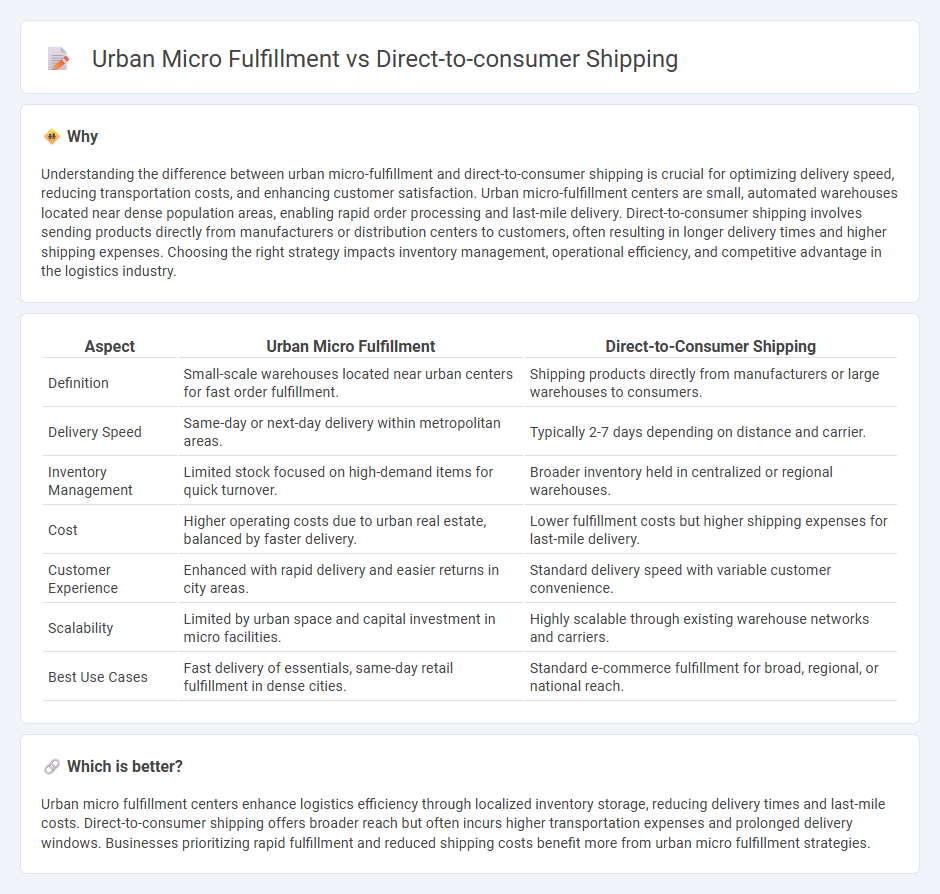
Urban micro-fulfillment centers strategically located within cities enable faster delivery and reduced shipping costs compared to traditional direct-to-consumer shipping, which relies on centralized warehouses and longer transit times. These micro-fulfillment hubs leverage automation and proximity to consumers to enhance order accuracy and meet rising demand for same-day or next-day delivery. Explore how urban micro-fulfillment is transforming last-mile logistics and reshaping consumer expectations.
Why it is important
Understanding the difference between urban micro-fulfillment and direct-to-consumer shipping is crucial for optimizing delivery speed, reducing transportation costs, and enhancing customer satisfaction. Urban micro-fulfillment centers are small, automated warehouses located near dense population areas, enabling rapid order processing and last-mile delivery. Direct-to-consumer shipping involves sending products directly from manufacturers or distribution centers to customers, often resulting in longer delivery times and higher shipping expenses. Choosing the right strategy impacts inventory management, operational efficiency, and competitive advantage in the logistics industry.
Comparison Table
| Aspect | Urban Micro Fulfillment | Direct-to-Consumer Shipping |
|---|---|---|
| Definition | Small-scale warehouses located near urban centers for fast order fulfillment. | Shipping products directly from manufacturers or large warehouses to consumers. |
| Delivery Speed | Same-day or next-day delivery within metropolitan areas. | Typically 2-7 days depending on distance and carrier. |
| Inventory Management | Limited stock focused on high-demand items for quick turnover. | Broader inventory held in centralized or regional warehouses. |
| Cost | Higher operating costs due to urban real estate, balanced by faster delivery. | Lower fulfillment costs but higher shipping expenses for last-mile delivery. |
| Customer Experience | Enhanced with rapid delivery and easier returns in city areas. | Standard delivery speed with variable customer convenience. |
| Scalability | Limited by urban space and capital investment in micro facilities. | Highly scalable through existing warehouse networks and carriers. |
| Best Use Cases | Fast delivery of essentials, same-day retail fulfillment in dense cities. | Standard e-commerce fulfillment for broad, regional, or national reach. |
Which is better?
Urban micro fulfillment centers enhance logistics efficiency through localized inventory storage, reducing delivery times and last-mile costs. Direct-to-consumer shipping offers broader reach but often incurs higher transportation expenses and prolonged delivery windows. Businesses prioritizing rapid fulfillment and reduced shipping costs benefit more from urban micro fulfillment strategies.
Connection
Urban micro fulfillment centers streamline logistics by positioning inventory closer to consumers, enabling faster direct-to-consumer shipping. This proximity reduces last-mile delivery costs and enhances order accuracy, critical for meeting consumer demand in dense urban areas. Efficient integration of these centers with direct-to-consumer models supports rapid delivery and optimizes supply chain responsiveness.
Key Terms
Last Mile Delivery
Direct-to-consumer shipping prioritizes delivering products straight from warehouses to customers, reducing storage layers and enabling traceable last-mile delivery with real-time tracking technology. Urban micro fulfillment centers enhance last mile delivery efficiency by positioning inventory closer to dense consumer populations, cutting delivery distances and time while supporting faster order processing within city environments. Explore our detailed analysis of how each approach optimizes last mile delivery performance and customer satisfaction.
Inventory Placement
Direct-to-consumer shipping relies on centralized warehouses to manage inventory, which can lead to longer delivery times and higher transportation costs. Urban micro fulfillment uses smaller, strategically located facilities within cities to optimize inventory placement, reducing last-mile delivery distances and increasing order speed. Explore how urban micro fulfillment enhances inventory management and improves customer satisfaction by visiting our detailed analysis.
Order Consolidation
Direct-to-consumer shipping often results in dispersed parcel shipments, increasing last-mile delivery costs and carbon emissions, whereas urban micro fulfillment centers enable order consolidation by aggregating multiple orders within compact urban warehouses, streamlining delivery routes and enhancing customer satisfaction. These micro fulfillment hubs leverage proximity to consumers to reduce transit times and minimize logistical complexity, making them ideal for high-density metropolitan areas. Explore the impact of order consolidation on supply chain efficiency and sustainability to optimize your fulfillment strategy.
Source and External Links
What Is DTC? Direct-to-Consumer Fulfillment Explained - Direct-to-consumer (DTC) shipping involves sending products directly from the brand's warehouse or dock to the customer, bypassing middlemen like distributors or retailers, which reduces costs and improves delivery speed and customer experience.
How Shipping Works for DTC Retailers - DTC shipping is the process where brands ship products directly to end users, avoiding intermediaries, to provide faster, more affordable, and customer-friendly fulfillment experiences.
Outlook for direct-to-consumer shipping changes in 2025 - The DTC shipping channel, especially for alcoholic beverages, remains dynamic and is expected to grow in 2025, with increased regulatory attention and consumer demand for remote purchase options.
 dowidth.com
dowidth.com